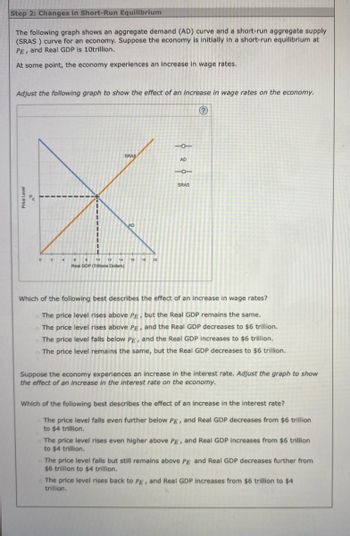
ENGR.ECONOMIC ANALYSIS
14th Edition
ISBN: 9780190931919
Author: NEWNAN
Publisher: Oxford University Press
expand_more
expand_more
format_list_bulleted
Question
Confused and not sure how to answer

Transcribed Image Text:Step 1: Short-Run Equilibrium
The following graph shows an aggregate demand (AD) curve and a short-run aggregate supply
(SRAS) curve for an economy. Suppose that the economy is initially in a short-run
equilibrium: at PE, and Real GDP is 10 trillion.
Suppose that at some point, the price increases to p*.
PRICE LEVEL
0 2
At p*, there is
firms
SRAS
6
B 10 12 14 16
REAL GDP (Trillion Dollars)
of $
AD
18 20
trillion goods. As a result, the price level
output, and consumers
consumption.
Step 2: Changes in Short-Run Equilibrium
The following graph shows an aggregate demand (AD) curve and a short-run aggregate supply
(SRAS) curve for an economy. Suppose the economy is initially in a short-run equilibrium at

Transcribed Image Text:Step 2: Changes in Short-Run Equilibrium
The following graph shows an aggregate demand (AD) curve and a short-run aggregate supply
(SRAS) curve for an economy. Suppose the economy is initially in a short-run equilibrium at
PE, and Real GDP is 10trillion.
At some point, the economy experiences an increase in wage rates.
Adjust the following graph to show the effect of an increase in wage rates on the economy.
(?)
Price Level
a
0
2
6
8 10 12 14
Real GDP (Trillions Dollars)
SRAS
AD
18
中田中器
SRAS
Which of the following best describes the effect of an increase in wage rates?
The price level rises above PE, but the Real GDP remains the same.
The price level rises above PE, and the Real GDP decreases to $6 trillion.
The price level falls below PE, and the Real GDP increases to $6 trillion.
The price level remains the same, but the Real GDP decreases to $6 trillion.
Suppose the economy experiences an increase in the interest rate. Adjust the graph to show
the effect of an increase in the interest rate on the economy.
Which of the following best describes the effect of an increase in the interest rate?
The price level falls even further below PE, and Real GDP decreases from $6 trillion
to $4 trillion.
The price level rises even higher above PE, and Real GDP increases from $6 trillion
to $4 trillion.
The price level falls but still remains above PE and Real GDP decreases further from
$6 trillion to $4 trillion.
The price level rises back to PE, and Real GDP increases from $6 trillion to $4
trillion.
Expert Solution
This question has been solved!
Explore an expertly crafted, step-by-step solution for a thorough understanding of key concepts.
This is a popular solution
Trending nowThis is a popular solution!
Step by stepSolved in 2 steps with 3 images

Knowledge Booster
Learn more about
Need a deep-dive on the concept behind this application? Look no further. Learn more about this topic, economics and related others by exploring similar questions and additional content below.Similar questions
- Sarah is unemployed if she is working at the accounting department of General Motor. is laid off and still looking for a job. has looked for a job for two months and then give up looking. is not looking for a job.arrow_forwardAre you able to assist me with the last two questions?arrow_forwardplease answer second question as a different question now!arrow_forward
arrow_back_ios
SEE MORE QUESTIONS
arrow_forward_ios
Recommended textbooks for you

 Principles of Economics (12th Edition)EconomicsISBN:9780134078779Author:Karl E. Case, Ray C. Fair, Sharon E. OsterPublisher:PEARSON
Principles of Economics (12th Edition)EconomicsISBN:9780134078779Author:Karl E. Case, Ray C. Fair, Sharon E. OsterPublisher:PEARSON Engineering Economy (17th Edition)EconomicsISBN:9780134870069Author:William G. Sullivan, Elin M. Wicks, C. Patrick KoellingPublisher:PEARSON
Engineering Economy (17th Edition)EconomicsISBN:9780134870069Author:William G. Sullivan, Elin M. Wicks, C. Patrick KoellingPublisher:PEARSON Principles of Economics (MindTap Course List)EconomicsISBN:9781305585126Author:N. Gregory MankiwPublisher:Cengage Learning
Principles of Economics (MindTap Course List)EconomicsISBN:9781305585126Author:N. Gregory MankiwPublisher:Cengage Learning Managerial Economics: A Problem Solving ApproachEconomicsISBN:9781337106665Author:Luke M. Froeb, Brian T. McCann, Michael R. Ward, Mike ShorPublisher:Cengage Learning
Managerial Economics: A Problem Solving ApproachEconomicsISBN:9781337106665Author:Luke M. Froeb, Brian T. McCann, Michael R. Ward, Mike ShorPublisher:Cengage Learning Managerial Economics & Business Strategy (Mcgraw-...EconomicsISBN:9781259290619Author:Michael Baye, Jeff PrincePublisher:McGraw-Hill Education
Managerial Economics & Business Strategy (Mcgraw-...EconomicsISBN:9781259290619Author:Michael Baye, Jeff PrincePublisher:McGraw-Hill Education


Principles of Economics (12th Edition)
Economics
ISBN:9780134078779
Author:Karl E. Case, Ray C. Fair, Sharon E. Oster
Publisher:PEARSON

Engineering Economy (17th Edition)
Economics
ISBN:9780134870069
Author:William G. Sullivan, Elin M. Wicks, C. Patrick Koelling
Publisher:PEARSON

Principles of Economics (MindTap Course List)
Economics
ISBN:9781305585126
Author:N. Gregory Mankiw
Publisher:Cengage Learning

Managerial Economics: A Problem Solving Approach
Economics
ISBN:9781337106665
Author:Luke M. Froeb, Brian T. McCann, Michael R. Ward, Mike Shor
Publisher:Cengage Learning

Managerial Economics & Business Strategy (Mcgraw-...
Economics
ISBN:9781259290619
Author:Michael Baye, Jeff Prince
Publisher:McGraw-Hill Education